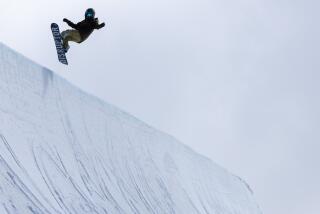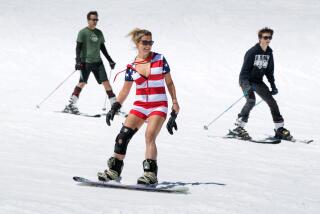Europe’s winter that wasn’t
- Share via
CORTINA D'AMPEZZO, ITALY — Up here in the Alpine Dolomites, the wide vista is painted with warm, vivid colors: swatches of deep-green pines, golden straw, grassy pastures and pink limestone ridges.
It would be an idyllic panorama -- if this were not the dead of winter and the height of the ski season in Italy’s most renowned, and most stylish, mountain resort. Just about the only snow to speak of these days is artificial, spewed from the “cannons” lining steep runs that wind for hundreds of yards down the jagged peaks.
Europe is enduring one of its warmest winters on record, part of a global trend of higher seasonal temperatures from here to the United States and beyond.
Throughout parts of Europe, flowers are blooming out of season, T-shirt weather is changing the winter dress code, and sports events are being postponed or abandoned. Ski-related businesses are suffering, and winter playgrounds from Austria to Spain have reported a drop in visitors.
“I’ve never seen it so green,” said Benedetta Scatafassi, a businesswoman in Rome who has been vacationing at her winter home in Cortina for years. Forgoing the skis this season, she decided to go to one of the spas that have sprung up in fancier hotels; in contrast to the slopes, the spa was packed.
Where snow once coated the village streets, yards and wooden chalets, a visitor today finds asphalt, apple trees bearing fruit and roofs with only a powdery dusting. The 6-foot yellow-and-black poles that measure snowdrifts at the roadside stand naked and lonely. Signs warn of rocks on the slopes.
“As a child, I used to jump out of my [second-story] window into the snow,” Cortina Mayor Giacomo Giacobbi, 40, said. “If I did that today, I’d break both legs.”
Giacobbi acknowledged that a major part of Cortina’s economy relies on the ski industry, but said he’s not worried -- yet. The town enjoys a popular summer season, and is looking at ways to diversify. There are plans for a golf course, and a 630-seat auditorium for congresses and similar events opened last month.
The problem is not so much the failure of snow to fall from the sky but that the temperatures have been so high that even making artificial snow isn’t easy, said Enrico Ghezze, head of the consortium that oversees the region’s 745-mile network of runs and 450 ski lifts.
The temperature must be 28.4 degrees to effectively produce artificial snow, he said, and it’s been that cold on very few occasions in the last month and a half. Otherwise, the ground stays too warm to hold the snow.
“We exploit every second it gets that cold to make snow,” he said.
Thanks to the artificial snow, it is still possible to ski. However, some slopes are closed, and skiers said some of the runs are overly icy, a function of the fake powder melting and refreezing.
The season, which is usually launched Dec. 7 for St. Ambrose Day, honoring the patron saint of northern Italy’s largest city, Milan, got off to a late start in most of the 12-valley, 45-resort Dolomite region. Only about half of the cross-country tracks are open; those skiers who favor “off-road” forays into the forest can forget it.
Still, Cortina can weather the impact of a soggy winter more than many resorts because its fame attracts visitors for more than just the downhill dashes.
Chic for nearly a century and host to the Winter Olympics 51 years ago, this is very much a place to see and be seen, despite an air of somewhat faded glory. Skiers here are some of the best-dressed men and women to hit the slopes. Corso Italia, the main promenade through Cortina, is sometimes called a Dolomite Rodeo Drive, with a quota of haute-couture boutiques, furriers and Swiss jewelers disproportionate to a village of 7,000 people.
On a glorious, bright day last week high above Cortina, at the 8,100-foot Ra Valles peak, waiters in short sleeves served hot chocolate piled high with whipped cream at an outdoor cafe. Some people were taking a break from skiing, while others, in fur-trimmed, lightweight parkas and perfectly applied makeup, were soaking up the sun.
Snow that had collected on the cafe’s roof was melting and falling off in chunks.
“It’s gorgeous -- maybe not good for nature, but good for us,” said Mirella Gattari, 30, dressed in a bright red ski suit and basking in the sunshine. Good for her tan, she meant.
Terry Hammond came to ski, all the way from Gold Coast, Australia. It may be the worst season in who-knows-how-long, he said, but it still beats Australia for skiing.
“Every lift you take, you can see there isn’t much snow,” he said as he hopped on a funicular headed for a higher peak. “You can only ski on the runs. Otherwise, it would be fantastic!”
Over at the foot of the Tofana peak, with skiers slaloming and schussing by, a visitor watched the temperature climb by about 2 degrees, to 50 degrees, in a matter of several minutes.
Giovanni Pompanin, who runs the ski lifts at Tofana, estimated that attendance was down by as much as 15%. Although people can ski, the panorama is incongruous -- striped and splotched with green and brown, rather than blanketed in white.
“With artificial snow, we manage, but we can’t make everyone happy,” he said.
The picture is similarly bleak elsewhere in Europe, although tourism officials throughout the region continue to evince optimism that the weather may improve. Globally, eight of the last 10 years are the warmest on record, and the British Meteorological Office has predicted that 2007 temperatures may be the highest yet.
Ski World Cup races in Chamonix, France, and Wengen, Switzerland, and elsewhere have been canceled, postponed or moved because of rain and warm temperatures. Resorts in eastern France’s Vosges range have reported layoffs, while numerous Alpine resorts are operating below capacity.
Back in Cortina, chef Eddie Calza, whose restaurant at the foot of Tofana whips up dishes of black-truffle polenta and deer tartar for his sophisticated skiing customers, said last month was the worst December he’d ever seen, and he was crossing his fingers for the rest of the season.
“If it doesn’t snow, this will get a lot worse, and then we’ll have to see where people will go,” he said. “We will probably just have to get used to this kind of weather.”
*
Times staff writers Maria De Cristofaro in Rome, Elisabeth Penz in Vienna and Achrene Sicakyuz in Paris contributed to this report.
More to Read
Sign up for The Wild
We’ll help you find the best places to hike, bike and run, as well as the perfect silent spots for meditation and yoga.
You may occasionally receive promotional content from the Los Angeles Times.







